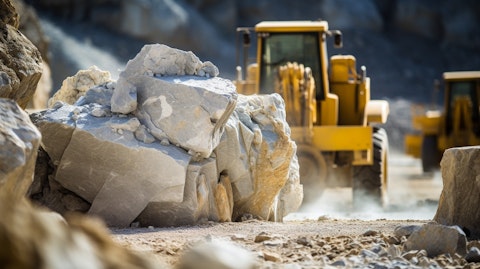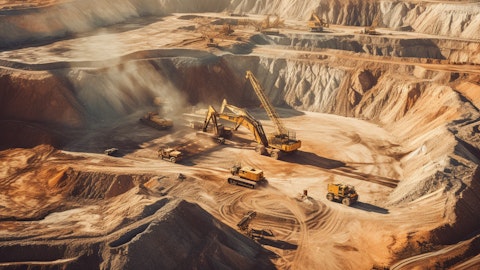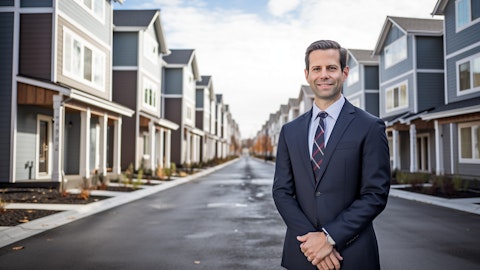Eagle Materials Inc. (NYSE:EXP) Q1 2026 Earnings Call Transcript July 29, 2025
Eagle Materials Inc. beats earnings expectations. Reported EPS is $3.91, expectations were $3.73.
Operator: Good day, everyone, and welcome to the Eagle Materials First Quarter of Fiscal 2026 Earnings Conference Call. This call is being recorded. At this time, I would like to turn the call over to Eagle’s President and Chief Executive Officer, Mr. Michael Haack. Mr. Haack, please go ahead, sir.
Michael R. Haack: Thank you, Chuck. Good morning. Welcome to Eagle Materials conference call for our First Quarter of Fiscal Year 2026. This is Michael Haack. Joining me today are Craig Kesler, our Chief Financial Officer; and Alex Haddock, Senior Vice President of Investor Relations, Strategy and Corporate Development. There will be a slide presentation made in connection with this call. To access it, please go to eaglematerials.com and click on the link to the webcast. While you’re accessing the slides, please note that the first slide covers our cautionary disclosure regarding forward-looking statements made during this call. These statements are subject to risks and uncertainties that could cause results to differ from those discussed during the call.
For further information, please refer to this disclosure, which is also included at the end of our press release. Thank you for joining us today. I’m pleased to report that we had a solid start to our fiscal year 2026. We generated record first quarter revenue of $634.7 million and diluted net earnings per share of $3.76 despite challenging weather conditions across many of our cement, concrete and aggregate markets. Throughout our history, our low-cost producer position and operational focus has helped us weather tougher periods in the cycle and capture the benefits of stronger conditions. Regardless of specific near-term conditions, our operations maintain the same disciplined focus every quarter and every year. Improving our operational metrics is always a key priority in this long-term multi-cycle approach to operational improvement is an important competitive advantage for Eagle Materials.
For me, that all starts with our safety performance. I’m pleased we continued our safety progress maintaining our total recordable incident rate well below the industry average and near our all-time record as a company. And as always, we aim to do better to establish our safety culture, so it is self-sustaining. The progress we’ve made is tangible and I’m grateful to our employees for their relentless efforts. We’ve also made substantial progress in our sustainability initiatives. Capturing the economic benefits of being a low-cost producer means sustainability has always been part of our operational DNA. We are always looking for ways to do more with less. Over the last 5-plus years, we have expanded our investments that offer us good returns, focused on improving our sustainability.
I think our progress is evidenced and our results across several initiatives, which can be found in our newly published updated sustainability report. To highlight just a few examples, we met our 2030 midterm cement CO2e intensity goal early. This does not mean we are done. We’ll continue to focus on efforts so we can improve this metric, operate more efficiently and provide a return to our investors. We continue to enhance our reporting. For example, in our most recent report, we separate cement GHG emissions by fuel and process for the first time. We also made investment in Terra CO2 as a lead investor to further our efforts to produce low-carbon supplementary cementitious material to help meet the expected future demand for cement more broadly.
Overall, I’m pleased with our progress and believe we still are in the early innings and will show further improvements. With that, let me turn to a few comments on our business environment. First, from a demand perspective, despite headline macroeconomic and policy uncertainty, we saw stable order trends across each of our major business lines. Our aggregates volumes improved meaningfully year-over-year, both from the integration of our 2 recently acquired quarries and on an organic basis. Our cement volumes also improved year-over-year, which is especially impressive given the major weather disruptions in several of our cement markets. This is the first quarter since December 2023 that we’ve seen a year-over-year increase in cement sales volumes.
Our heavy side customers continue to express cautious optimism for their business outlooks as DOT state budgets remain healthy and infrastructure awards accelerate. Against this backdrop, once cement sales volumes rebound from the slower than anticipated consumption we had in calendar 2023 and 2024, we believe the high capacity utilization rates across the cement industry should also lead to an improved pricing environment. Our near-term outlook on volumes for the Wallboard business remains more subdued. Single-family new homebuilding constraints persist primarily driven by affordability challenges for the new home buyer. For wallboard volumes to recover, interest rates and/or home prices will need to come down to aid buyer demand more broadly.

However, putting the current environment into context, annual consumption of wallboard sits at levels again to the late 1990s when the U.S. had a much lower population base. And despite the tougher residential construction environment, our Wallboard business has performed exceptionally well. Even against a softer demand environment, we have been able to maintain our margin profile across our businesses given our operational advantages. Our cement footprint is more modern than prior cycles, thanks to strategic acquisitions and in cement and wallboard structural constraints on adding supply remain. We believe long-term demand fundamentals favor the consumption of our products. U.S. infrastructure assets and the U.S. housing stock continue to age and the replenishment of our roads, bridges and homes will require cement, concrete and aggregates and wallboard.
That is why as we look out over the next 3 to 5 years, we believe we can continue to grow and expand our margins further. We also continue to prudently invest our substantial excess free cash flow. I recently visited our Laramie, Wyoming cement plant, and I’m happy with the progress we are making on modernizing and expanding the plant. The project remains on budget and on schedule for late calendar 2026 commissioning. Construction for our Duke, Oklahoma Wallboard plant modernization will also commence this summer, and we have already begun purchasing major equipment. Both projects highlight our investment philosophy well. We plan to continue to seek strategic projects, whether acquisitions or organic opportunities that meet our financial return criteria and position our company for the next 40 years or more.
Alongside these projects, we plan to continue to invest in our company through opportunistic share repurchases as well. There’s a lot of meaningful value- creating work underway at Eagle Materials, and I’m excited to share our progress along the way. With that, Craig, I’ll pass it over to you.
D. Craig Kesler: Thank you, Michael. As mentioned, first quarter revenue was a record $635 million, an increase of 4%. The increase primarily reflects higher Cement and Wallboard sales volume as well as the contribution from the recently acquired aggregates businesses. Excluding the acquired businesses, consolidated revenue was up 2%. First quarter earnings per share were down 5% to $3.76. The decrease was driven by lower earnings, mostly in cement as a result of higher operating costs, partially offset by a 3% reduction in fully diluted shares due to our share buyback program. Turning now to segment performance highlighted on the next slide. In our Heavy Materials sector, which includes our Cement and Concrete and Aggregates segments, revenue was up 5%, driven primarily by increased cement sales volume and a 21% increase in concrete and aggregates revenue.
Aggregate sales volume was up 117%, including the contribution from the recently acquired aggregates businesses. Organic aggregate sales volume was up 29%. Operating earnings in the sector were down 5%, primarily because of the impact of lower production volumes on fixed costs as well as increased raw material costs. Moving to the Light Materials sector on the next slide. First quarter revenue in our Light Materials sector increased 1%, reflecting higher wallboard sales volume, partially offset by lower wallboard sales prices. Operating earnings in the sector were down slightly reflecting lower net sales prices, partially offset by lower input costs, primarily for recycled fiber. Looking now at our cash flow. We continue to generate substantial cash flow and allocate capital in a disciplined way.
In the first quarter, operating cash flow increased by 3% to $137 million, reflecting improved working capital management. Capital spending increased to $76 million as we continue to invest in and improve our operations. Most of the increase was associated with the modernization and expansion of our Mountain Cement plant and equipment purchases for the project to modernize our Duke, Oklahoma Wallboard facility. These two projects as well as our sustaining capital spending, we continue to expect total company capital spending in fiscal 2026 to be in the range of $475 million to $525 million. We repurchased 358,000 shares of our common stock for $79 million and paid our quarterly dividend, returning $87 million to shareholders during the first quarter.
We have 4.3 million shares remaining under our current repurchase authorization. Finally, a look at our capital structure, which continues to give us significant financial flexibility. At June 30, our net debt-to-cap ratio remained at 46%, and our net debt-to-EBITDA leverage ratio was 1.6x. We ended the quarter with $60 million of cash on hand. Total committed liquidity at the end of the quarter was approximately $525 million, and we have no meaningful near-term debt maturities. Thank you for attending today’s call. We’ll now move to the question-and-answer session.
Q&A Session
Follow Eagle Materials Inc (NYSE:EXP)
Follow Eagle Materials Inc (NYSE:EXP)
Receive real-time insider trading and news alerts
Operator: [Operator Instructions] And the first question will come from Trey Grooms with Stephens.
Trey Grooms: Good morning, everyone. If you could maybe touch on Wallboard here. I mean you guys are clearly outperforming the market. Maybe touch on some of the drivers there. And maybe what you’re seeing on the demand front. Housing continues to be pretty weak, but I’d say you guys are outperforming there. So any color you could give us around that.
D. Craig Kesler: Yes, Trey. Look, I think some of it is our geographic position continues to do well. And you’ve heard me say this many times, also looking at volumes on a trailing 12-month basis is important. Quarter-to-quarter, you could have weather issues, you could have projects that shift around. But we’re happy with where our businesses are positioned. Our facilities are in good condition and the team is performing well. No doubt, and as Michael mentioned, the affordability issues continue to plague the housing industry, but — and wallboard volumes are still at very low levels in the grand scheme of things. So we like our position. And as we can improve the affordability issue in the United States, I think our business is positioned very, very well.
Trey Grooms: Okay. And then kind of sticking with Wallboard, the margins there continue to be really good. Can you talk about anything on the cost front we should be kind of keeping an eye out for on the Wallboard side? Any swings there or any changes that you’re expecting on that front?
D. Craig Kesler: Look, natural gas has pretty been range-bound for quite some time now. It’s a little over $3 a million. OCC prices have come down. I think they probably stabilized at this level for a little while. We’re fortunate with our natural gypsum reserves and having plenty of those for many years, many decades. And so I don’t see anything on the immediate horizon one way or the other on the cost side.
Operator: Your next question will come from Brian Brophy with Stifel.
Brian Daniel Brophy: The JV operating earnings were a little bit lower than the Street was. I guess just curious to what extent that was a continuation of a drag from the slag facility ramp-up? And just any update on how you guys are thinking about that ramp moving forward here?
D. Craig Kesler: Yes. Look, I think there were two things in the quarter. You hit on one of them. Certainly as we commissioned that facility during the winter, and it’s really in start-up mode as we’ve gone through the spring and early summer. So that did continue to be a drag on earnings. The business is starting up and will continue to improve I think as we go along this year. The other point, and you see it in the release, sales volumes were down 12%. Texas continued to see some weather issues across the whole state. And that’s certainly contributed to the decline in volumes.
Brian Daniel Brophy: That’s helpful. And then on the flip side, obviously, there was a nice bounce back in profitability on the concrete and ag side. Is this a good run rate to think about margins moving forward in that segment? Or is there any kind of one-off benefits to call out this quarter?
D. Craig Kesler: Yes. No onetime issues or onetime benefits. I would tell you like many of these businesses that are outdoor sports, there will be some seasonality as you get into the December and certainly in the March quarter. But here in the June and September quarter, those businesses performed well. We had some unique items last year that we had highlighted several times. I think we’re past many of those. So you’re right, the business did perform very well. They’ll have natural seasonality to it, but very happy.
Operator: Your next question will come from Anthony Pettinari with Citigroup.
Anthony James Pettinari: I was wondering with the strength you saw in cement volumes, if there was anything notable in terms of the cadence in the 3 months of the quarter and then maybe quarter-to-date here in July, whether — I don’t know, the strength has built or there’s any pattern there? And then I’m wondering if you could talk a little bit more about maybe some of the regional or state-by-state dynamics that you’re seeing in the cement market.
D. Craig Kesler: Yes. Thanks, Anthony. Look, I would tell you, the volume cadence was pretty consistent throughout the quarter. And as we’ve highlighted for a while now, the underpinning of cement demand is driven by infrastructure spending. Those awards have continued to accelerate. And so feel good about where that business is from a volume perspective. I think it’s been pretty consistent throughout the quarter and expect it to remain so, even in light of some weather pressures and Michael mentioned that we had some areas of the country, especially in places like Oklahoma, where they saw a year’s worth of rain in the first half of the year. So even with that environment, we continue to see a nice improvement in cement volumes steady.
Anthony James Pettinari: Great. Great. And is there any notable dynamic that you call out in the states that you serve, areas that are stronger or maybe weaker?
Michael R. Haack: No. Really, if you look across the country, it’s pretty consistent across the country with it. We don’t have anything that I’d call out as specific that’s a big deviation compared to any other location.
Operator: Your next question will come from Adam Thalhimer with Thompson, Davis.
Adam Robert Thalhimer: Nice quarter. Craig, can you give us any high-level thoughts on Wallboard volumes going forward?
D. Craig Kesler: Yes, Adam. Look, again, very happy with how the business performed through the June quarter as well chronicled and we’ve discussed here a little bit. I mean, housing has been under some pressure given where interest rates are and just general affordability issues. So look, I don’t see a major change one way or the other in wallboard demand frankly. But it’s kind of a hard crystal ball right now to figure out where homebuilding is going. Certainly, I think the spring selling season wasn’t as strong as the homebuilders had hoped for, but still feel good about kind of the medium and longer-term housing issue here in the U.S. with — we still feel like we are underbuilt and as long and we’ve got healthy consumers, healthy balance sheets. So when we do see affordability improve, I think that’s when wallboard volumes can really meaningfully move forward.
Adam Robert Thalhimer: Okay. And then on Cement, I was curious if the higher operating costs you called out, were those temporary in the quarter?
D. Craig Kesler: Yes, Adam, great question. This is our quarter where we perform the vast majority of our annual maintenance programs and production was lower during this quarter. And so on a per unit basis, that lower production volume really hurts your fixed cost absorption. So pretty unique to this quarter. I wouldn’t call out anything. Energy was pretty flat even both on a fuel and electricity basis. It was just really the lower production volumes associated with those annual maintenance programs.
Operator: Next question will come from Philip Ng with Jefferies.
Philip H. Ng: On cement, Michael, I think if I heard you correctly, your commentary on the outlook with capacity utilization high, you were pretty upbeat on cement prices. I don’t know if that was a medium to longer-term comment, but I’d love to get your thoughts on how you’re seeing cement prices evolve over the course of the year. It sounds like demand is reasonably good, but prices slipped modestly sequentially. So just kind of give us a lay of land how you’re thinking about cement prices this year.
Michael R. Haack: Yes, Phil, thanks for the question. When we look at it, if we look at the — what I continue to focus on is kind of the midterm and the long-term side, of the market. And when we look at it, demand is staying pretty consistent and pretty stable. We’re happy with the volumes we were able to ship. And as I stated earlier, it’s pretty consistent across the country. So from what we’re hearing from customers and everything, we think the demand profile in the midterm and the long-term would be good, which would lead to more pricing potential in the future as those supply-demand dynamics tighten with it. In the shorter-term time frame, we have a good supply-demand dynamic right now. But I think the shorter-term, I won’t say we’ll be a little bit more challenged in getting price increases through, but it will be more pacing them looking at the fall to see what we do and what we implement during that timeframe.
So really, what I’m looking for is the midterm and the long-term that has really more potential and upside on that.
Philip H. Ng: Okay. Just I’m interpreting you correctly, Michael, the spring increase, TBD probably fairly muted, and it kind of depends on how the demand backdrop, supply/demand on fall kind of materializes and potentially that could give you some momentum on pricing for cement?
Michael R. Haack: That’s exactly correct, Phil.
Philip H. Ng: Okay. Perfect. And perhaps a question for you, Craig, with the build change out there, and you guys are obviously making real investments in both your Cement and wall business. Anything to be mindful of from a cash flow standpoint and potentially cash tax implications?
D. Craig Kesler: You hit the nail on the head, Phil. Yes, from a P&L perspective, not a big change, but with the accelerated depreciation being extended, that should help reduce cash taxes paid, not as significant here in fiscal ’26 but when you consider a project like the Mountain Cement modernization, a $430 million investment expected to be put in place in fiscal ’27, that would be an immediate full deduction. So it would significantly lower our cash taxes paid. So — and then the following year, you have the Duke Wallboard expansion project coming online in addition to your normal sustaining capital spending. So it will — yes, it will be a nice boost to cash flow.
Philip H. Ng: Is there a way to kind of size what that cash tax rate could look like in the next few years?
D. Craig Kesler: Our cash taxes paid, frankly, aren’t that much different than our provision, so kind of the low 20s. And so pretax income that could be a pretty meaningful number.
Operator: Next question will come from Keith Hughes with Truist.
Keith Brian Hughes: I just want to shift over to wallboard pricing was down in the quarter you talked about. Was there any mix impact on the numbers and what’s — in the near term, what do you think pricing will do?
D. Craig Kesler: Yes, Keith. Really the decline year-over-year, yes, sequentially, pretty much flat. And so we had already seen that decline really in the second half of calendar ’24 and into our Q4. So been pretty range-bound here with wallboard prices for quite some time. And I think our outlook is for a similar type of range-bound until you have a meaningful move in volume.
Operator: This concludes our question-and-answer session. I would like to turn the conference back over to Mr. Michael Haack for any closing remarks. Please go ahead, sir.
Michael R. Haack: Thank you, Chuck. The first quarter was a solid start to our year, which is a testament to our operational resilience. We have maintained our clear operational, strategic and financial goalposts even as the economy and construction conditions evolve. Eagle continues to position itself for growth throughout the cycle, and we will keep focused on executing for outperformance. Thanks also for everyone for joining the call today. We look forward to discussing our results again with you next quarter.
Operator: The conference has now concluded. Thank you for attending today’s presentation. You may now disconnect.
Follow Eagle Materials Inc (NYSE:EXP)
Follow Eagle Materials Inc (NYSE:EXP)
Receive real-time insider trading and news alerts




